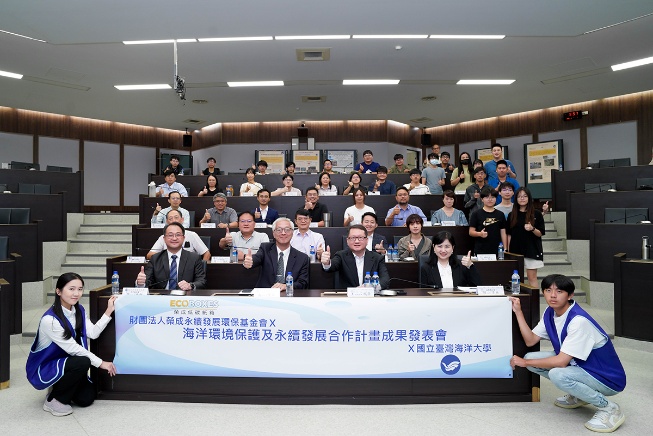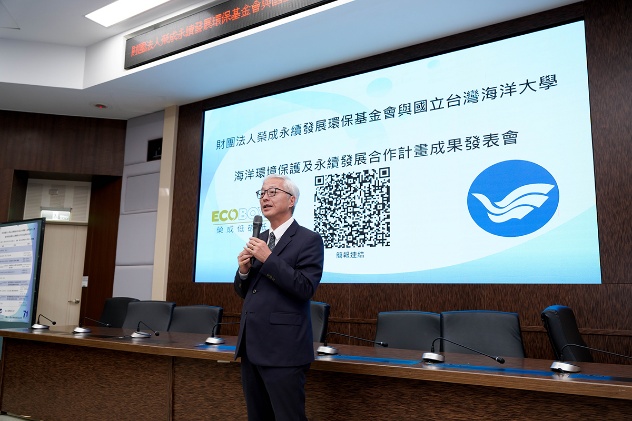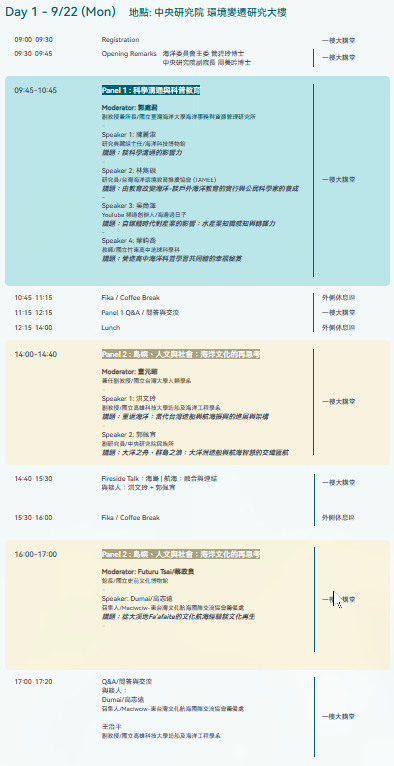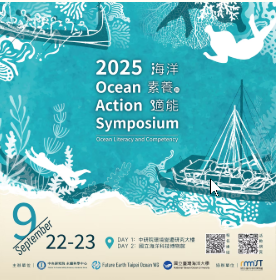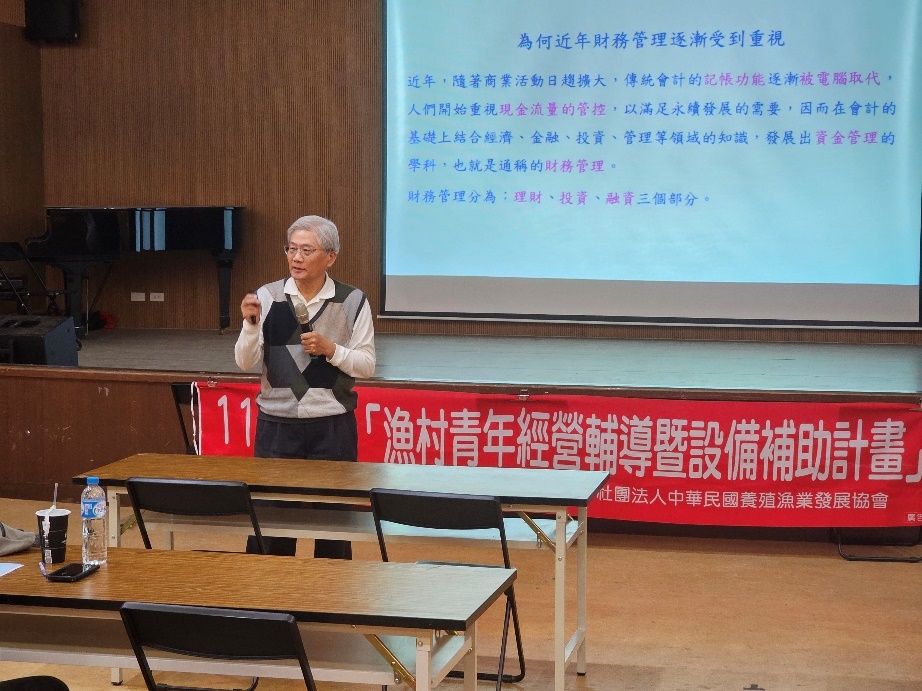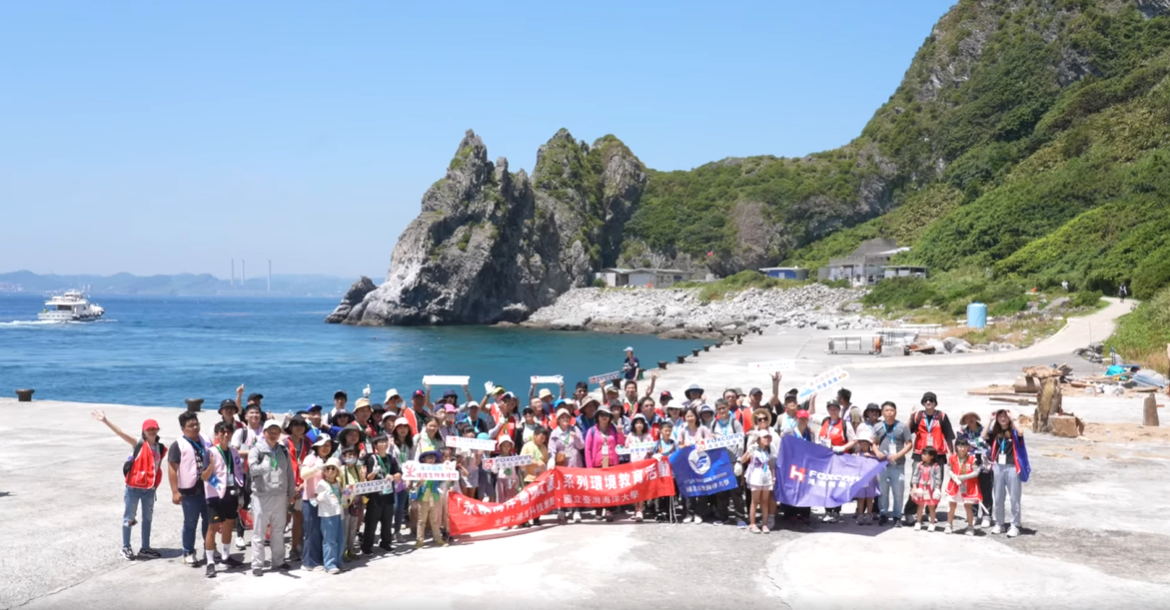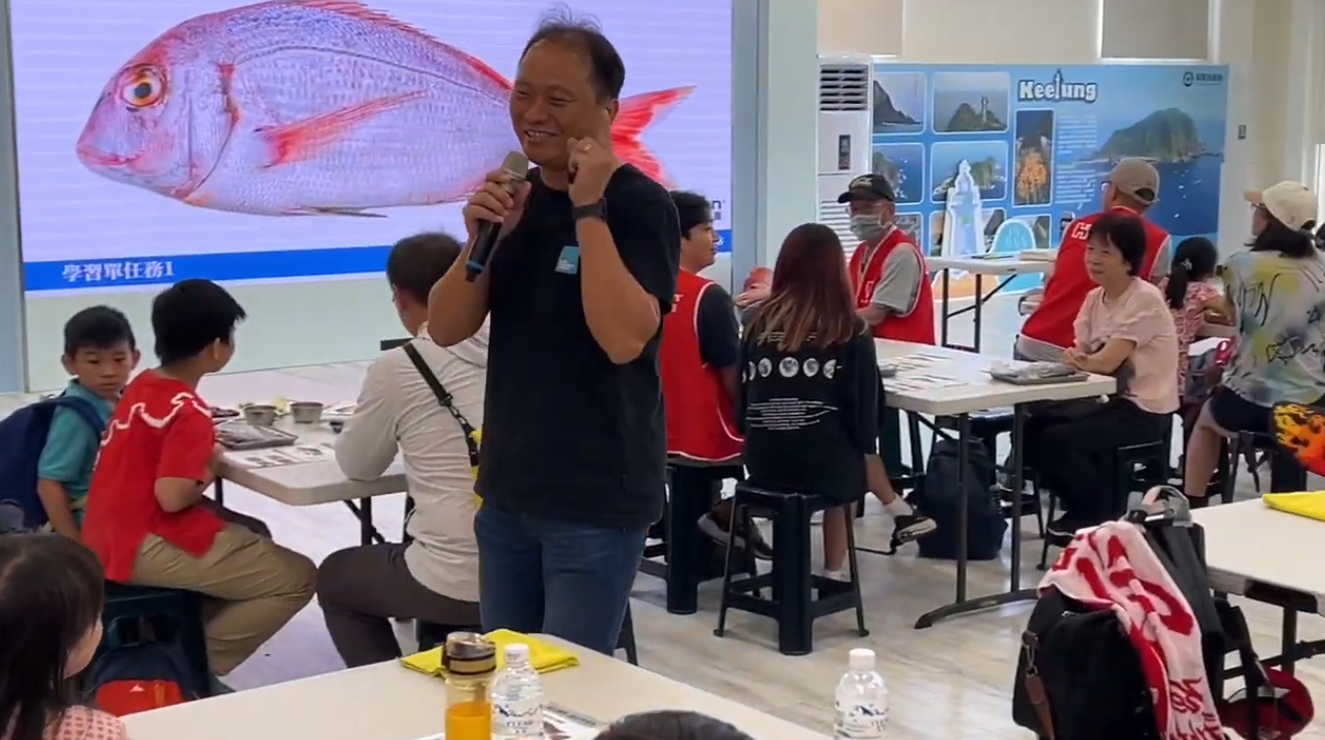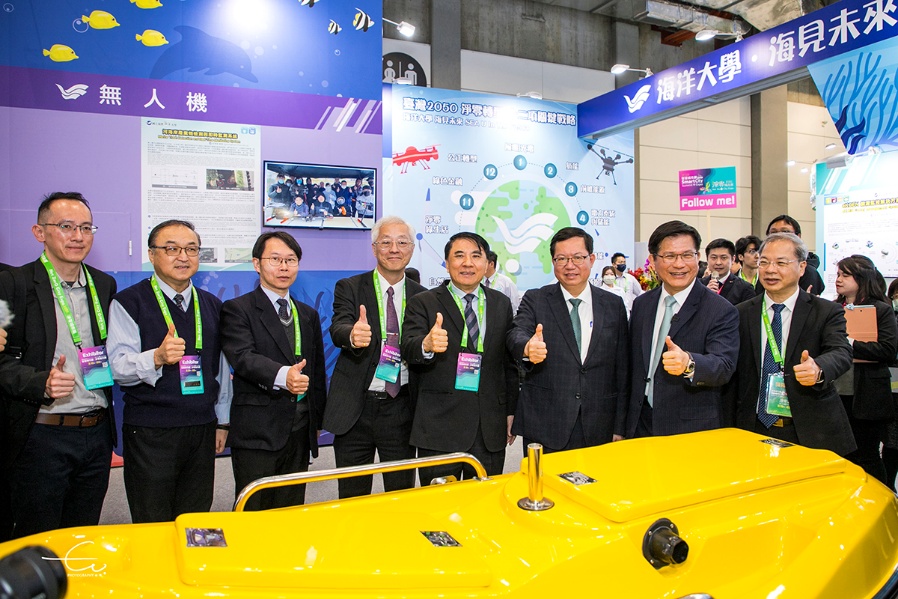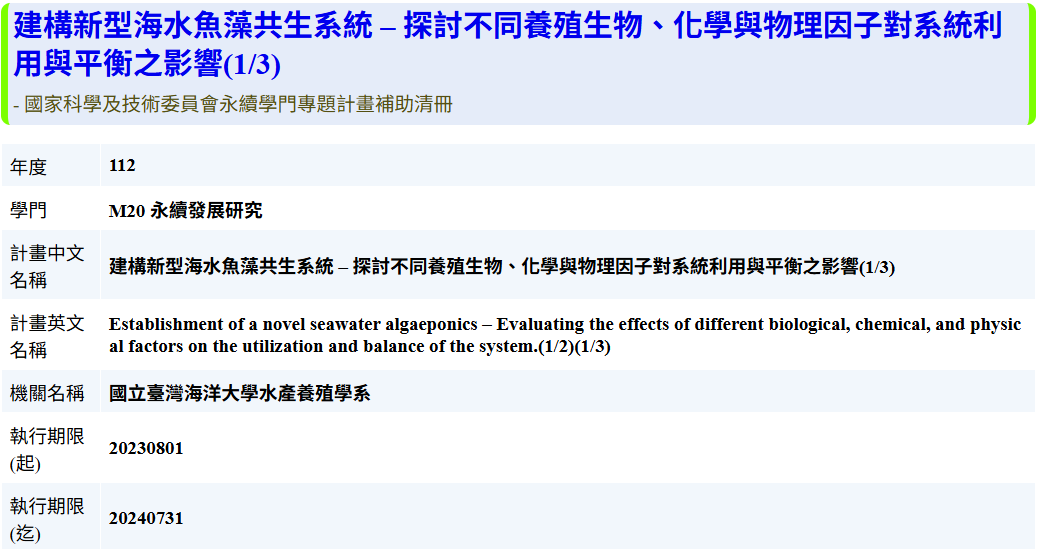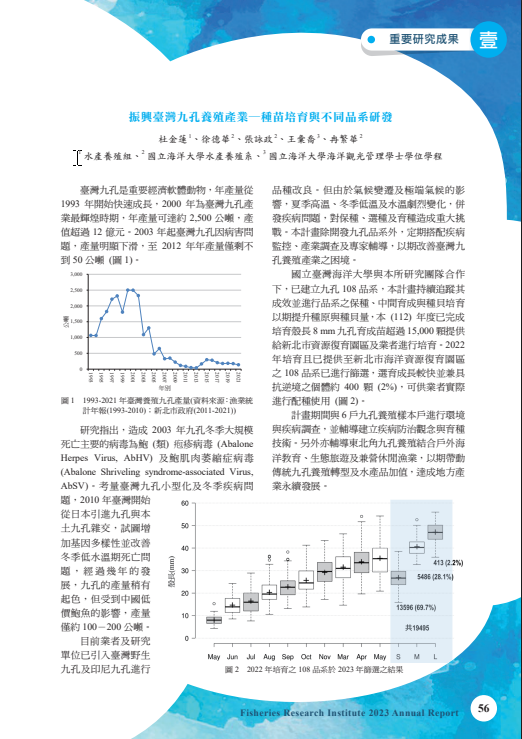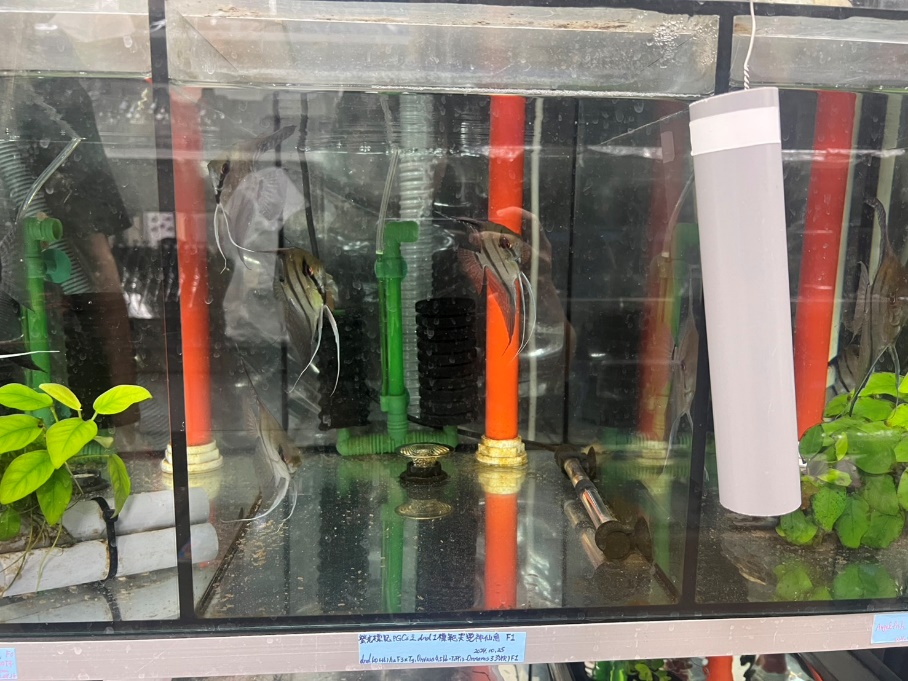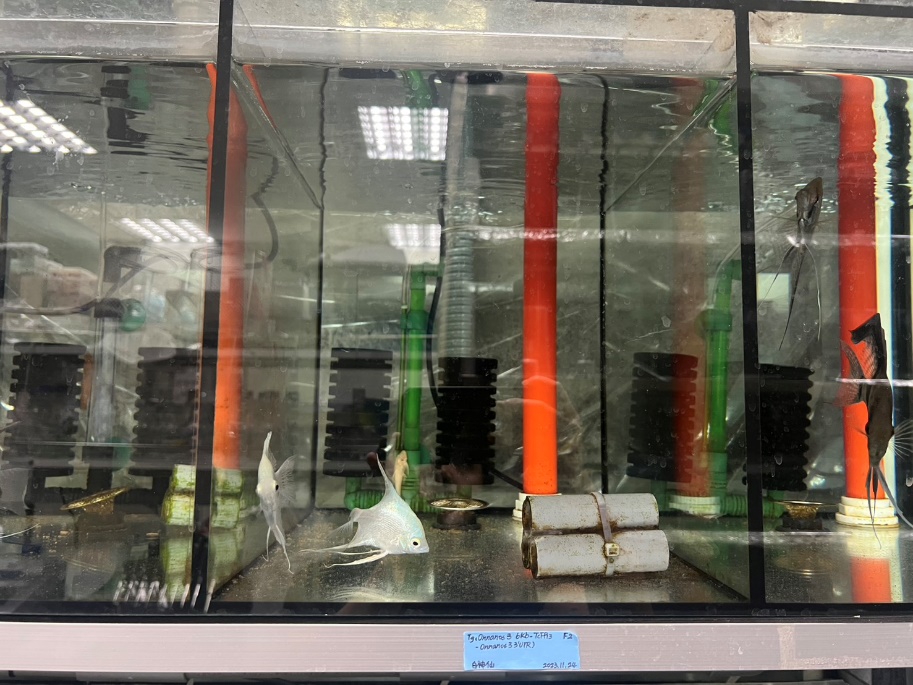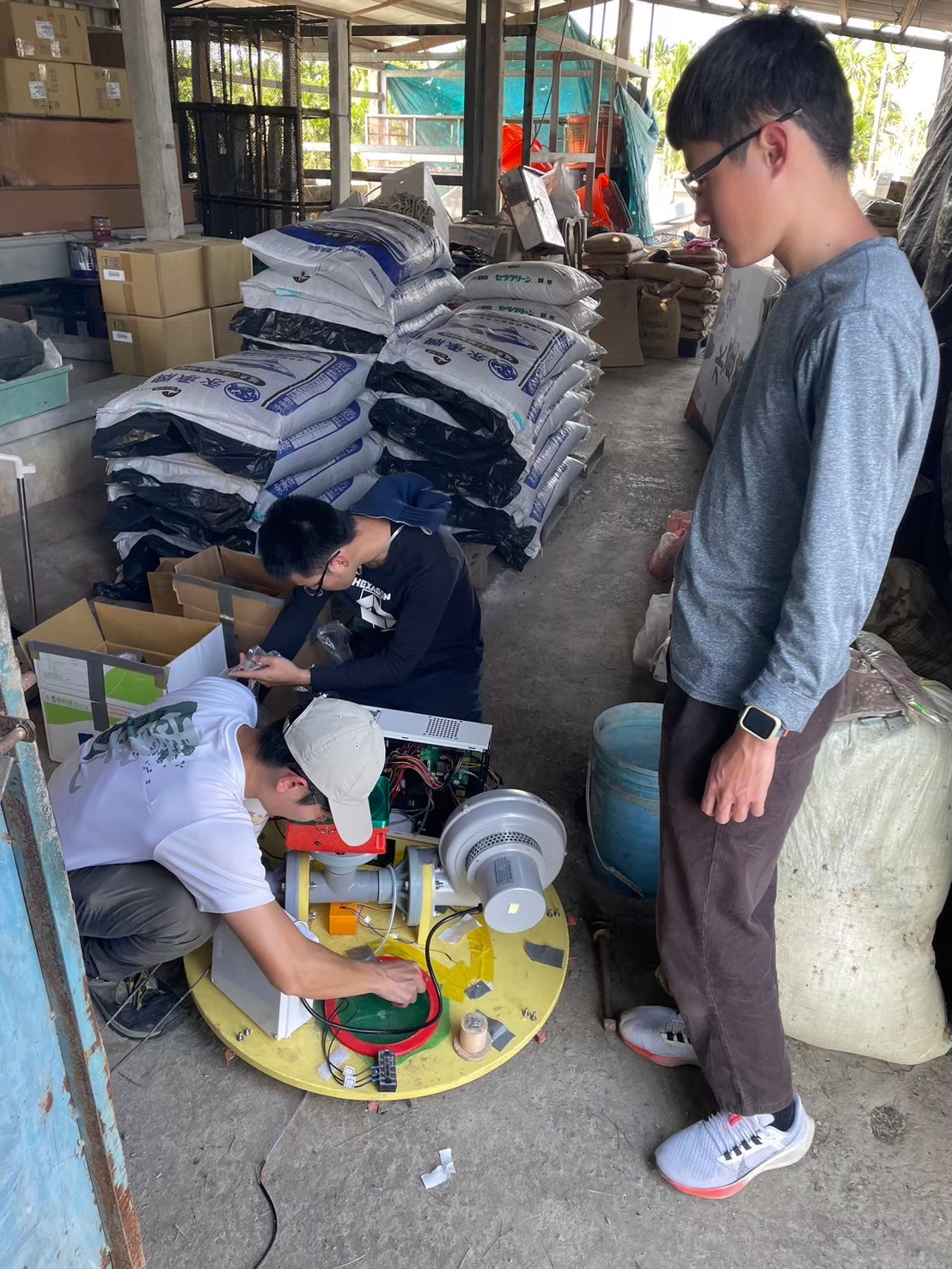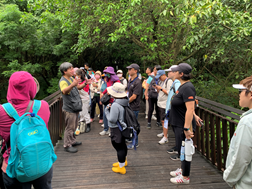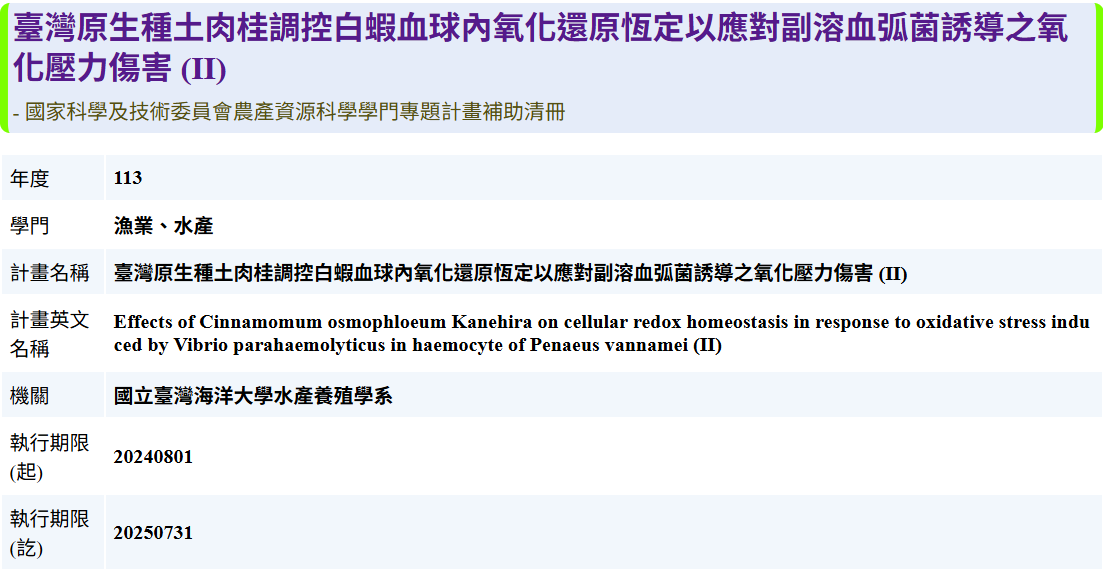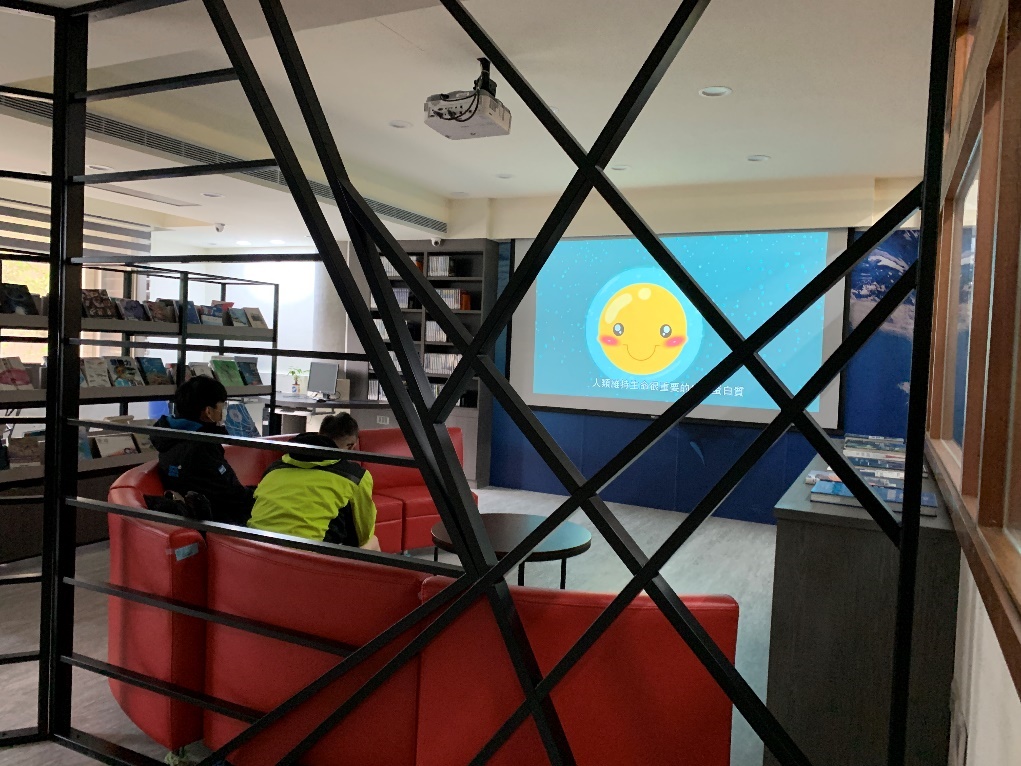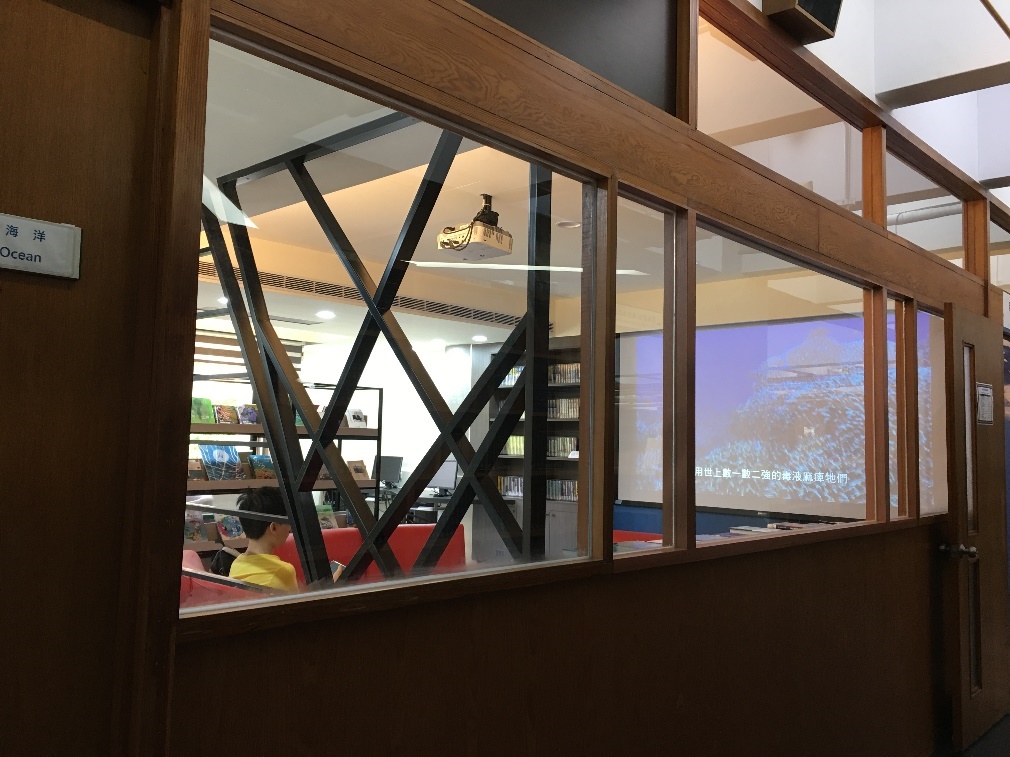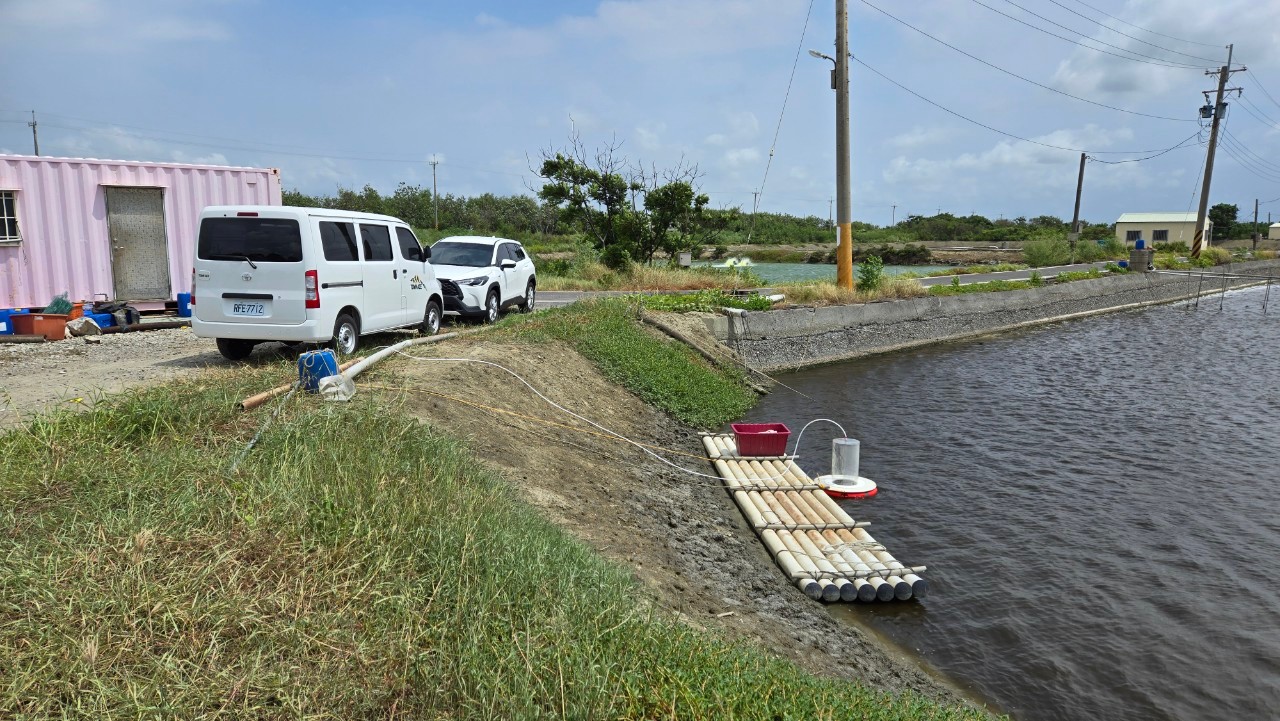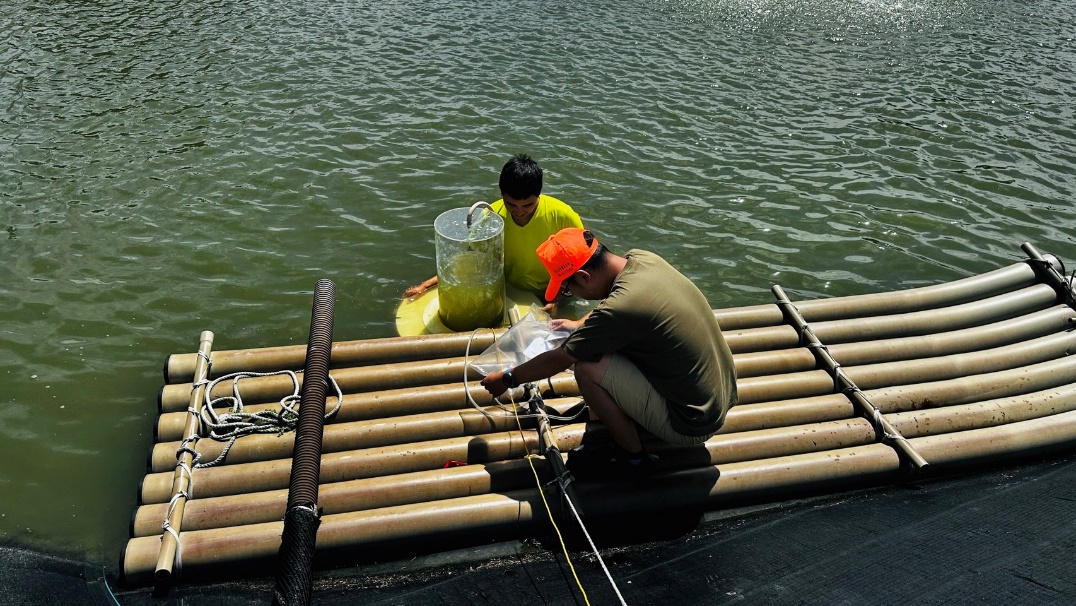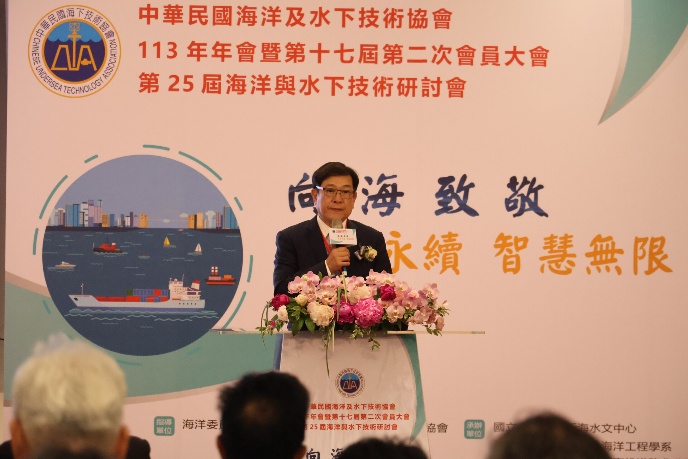14.3.1
1. 2024 Longchen Paper & Packaging Co., Ltd. and National Taiwan Ocean University Joint Project Results Presentation Conference
2024財團法人榮成永續發展環保基金會與國立臺灣海洋大學合作計畫成果發表會
Since 2019, National Taiwan Ocean University and Longchen Paper & Packaging Co., Ltd. have jointly launched a collaboration project on Marine Environmental Protection and Sustainable Development. Each year, Longchen Paper & Packaging Co., Ltd. has provided over NT$2 million in funding to support the implementation of related programs at our university. In 2024, marking the fifth anniversary of this partnership, a Results Presentation Conference was held at our university to showcase and promote the achievements of the collaboration. The event was attended by approximately 80 participants, who listened to the project outcomes. To date, 29 students have taken part in the program, deeply embedding the concept of sustainable development in their minds and actions.
Sustainable Impact:Since 2019, the university has partnered with the Rongcheng Foundation for Sustainable Development to implement projects on "Marine Environmental Protection and Sustainable Development," with over NT$2 million in annual funding. Over five years, this collaboration exemplifies SDG 17.2.5 through a long-term public–private partnership advancing marine sustainability. The initiative integrates marine ecosystem protection (SDGs 14.2.2, 14.2.3), ocean research and education (14.3.1, 14.3.3), sustainable fisheries management (14.4.2, 14.4.3), and conservation area promotion (14.5.2), while also fostering climate awareness (13.3.5). The 2024 results symposium showcased achievements to around 80 attendees and engaged 29 students in hands-on projects, embedding sustainability values and demonstrating the power of academia–foundation collaboration in advancing marine conservation and climate education.
本校與財團法人榮成永續發展環保基金會自2019起開展「海洋環境保護及永續發展」合作案,由榮成永續發展環保基金會每年提供超過200萬元經費供本校執行相關計畫。2024年雙方合作滿5年,故決定於本校舉辦成果發表會,推廣合作成果。 發表會當日共有約80人出席聆聽計畫成果,本合作更已有29位學生參與計畫,將永續發展的觀念深植於心。
永續影響力:本校自2019年與榮成永續發展環保基金會合作推動「海洋環境保護及永續發展」計畫,每年投入逾200萬元資源,持續五年推展海洋教育與保育行動,展現公私協力落實SDG 17.2.5「建立長期夥伴關係」。計畫內容涵蓋海洋生態保育(14.2.2、14.2.3)、海洋研究與教育推廣(14.3.1、14.3.3)、漁業與資源永續利用(14.4.2、14.4.3)、以及海域保護區推動(14.5.2),並融入氣候行動教育(13.3.5)。成果發表會除促進知識分享,也吸引29位學生參與,深化永續素養與行動實踐,展現學界與基金會共同推動海洋永續的成效。
|
|
|
Evidence:
https://research.ntou.edu.tw/p/412-1021-12463.php?Lang=zh-tw
2. Early Career Ocean Professional (ECOP) Listening Sessions
早期職業海洋專業人士 (ECOP)聆聽工作坊
The listening sessions revealed that youth from diverse backgrounds in Taiwan—ECOPs, Indigenous youths, and young Ocean Educators—share strong concerns about marine pollution and ecosystem degradation. Across all groups, ‘Challenge 1: Understand and beat marine pollution' and ‘Challenge 2: Protect and restore ecosystems and biodiversity' were consistently ranked among the top three priorities. While the third priority varied, each group brought unique perspectives shaped by their experiences and professional or cultural contexts. All participants acknowledged that Taiwan has demonstrated significant strengths in marine ecosystem restoration and possesses the capacity to contribute valuable expertise and technology to global ocean sustainability. However, over 60% of ECOPs and Indigenous youth participants had never heard of the UN Ocean Decade, largely due to Taiwan's exclusion from formal UN processes. Despite Taiwan's fisheries and shipping sectors ranking among the top globally, it remains excluded from many international negotiations, resulting in a critical gap in global ocean data and perspectives. The participants called for more inclusive and culturally grounded ocean governance that integrates the knowledge and efforts of non-state actors, including Indigenous communities. Their collective messages urge that Taiwan's marine expertise and perspectives be meaningfully included in international dialogues—ensuring ocean sustainability efforts reflect diverse voices and local realities.
Sustainable Impact:This dialogue gathered Taiwanese youth from diverse backgrounds—environmental advocates, Indigenous leaders, and marine educators—to discuss ocean pollution, ecosystem degradation, and inclusive governance. Participants recognized Taiwan's strong technical capacity in marine ecosystem restoration but highlighted its exclusion from UN Ocean Decade processes, resulting in significant data and representation gaps. Over 60% of attendees had never heard of the UN Ocean Decade, underscoring the need for greater international engagement. The forum called for culturally grounded and inclusive ocean governance that integrates Indigenous knowledge and non-state actors' expertise. It emphasized Taiwan's potential contribution to global marine sustainability through science, education, and policy innovation. This initiative aligns with SDG 14 (Life Below Water), promoting conservation and sustainable management of ocean resources; SDG 17 (Partnerships for the Goals), strengthening global collaboration; and SDG 4.3.5, enhancing educational awareness and professional capacity for sustainable ocean action.
聆聽環節發現,來自不同背景的台灣青年——環保青年、原住民青年和青年海洋教育者——都對海洋污染和生態系統退化有著強烈的擔憂。在所有群體中,「挑戰一:了解並戰勝海洋污染」和「挑戰二:保護和修復生態系統與生物多樣性」始終位列三大優先事項之列。雖然第三個優先事項各不相同,但每個群體都根據自身的經驗、專業或文化背景提出了獨特的觀點。所有參與者都承認,台灣在海洋生態系統修復方面展現出顯著優勢,有能力為全球海洋永續發展貢獻寶貴的專業知識和技術。然而,超過 60% 的環保青年和原住民青年參與者從未聽說過聯合國海洋十年,主要是因為台灣被排除在聯合國正式進程之外。儘管台灣的漁業和航運業在全球名列前茅,但它仍然被排除在許多國際談判之外,導致全球海洋數據和觀點有重大缺口。與會者呼籲更具包容性、以文化為基礎的海洋治理,整合包括原住民社群在內的非國家行為體的知識和努力。他們共同呼籲,將台灣的海洋專業知識和觀點有效納入國際對話,確保海洋永續發展努力反映多元聲音和本土現實。
永續影響力:本活動匯集來自不同背景的台灣青年,包括環保青年、原住民青年及海洋教育者,共同探討海洋污染、生態系退化及多元文化參與等議題。與會者一致認為,台灣在海洋生態修復上具備專業能力與技術優勢,應積極參與全球海洋治理。然而,超過六成的青年未曾聽聞「聯合國海洋十年」,顯示台灣在國際海洋永續進程中被邊緣化的困境。與會者呼籲建立更具包容性的國際對話平台,納入原住民與非國家行為者的知識與經驗,並促進海洋教育與文化治理的融合。此舉不僅推動跨文化合作與教育提升,也體現SDG 14「海洋生態永續」、SDG 17「夥伴關係」、及SDG 4.3.5「教育與專業能力增能」之核心精神。
|
|
Evidence:
https://www.facebook.com/photo.php?fbid=691210616572785&id=100070515593897&set=a.220356423658209
3. 2025 Ocean Action Symposium
海洋素養與適能
What is your vision of "ocean literacy"? Ocean literacy is more than just textbook knowledge; it's a way of looking at the world—it influences our values and shapes our motivation to act. Have you ever considered this? Every breeze, every current, every ship, every story of the sea—they are inextricably linked to our lives and culture. How do Taiwan's tides and ocean currents affect residents of the island and its outlying islands? How have shipbuilding and navigational technology shaped Taiwan's unique maritime culture? And what significance do coral conservation efforts have for the marine environment? This year's symposium invited scholars from across disciplines, educators on the front lines, representatives from the marine restoration industry, and marine cultural activists to share their insights! The symposium focused on themes of science communication and popular science education, marine culture and island society, and social participation and marine restoration.
Sustainable Impact:The "Ocean Literacy" symposium redefines ocean awareness as more than academic knowledge—it is a worldview that connects science, culture, and action. The event invited interdisciplinary experts, educators, and marine restoration practitioners to explore three key themes: science communication and public education, marine culture and island society, and social participation in ocean restoration.Through discussions on topics such as coral conservation, shipbuilding traditions, and community-based marine stewardship, the symposium encouraged participants to view the ocean as an integral part of life and identity.This initiative not only enhances public understanding of marine sustainability but also strengthens collaborations among academia, education, and industry.It exemplifies SDG 14 (Life Below Water) by promoting ocean conservation awareness, and SDG 17 (Partnerships for the Goals) by fostering multi-sector partnerships for sustainable ocean development and education.
你對「海洋素養」的想像是什麼? 海洋素養,不只是課本上的知識,更是一種看待世界的方式——它關係著我們的價值觀,也形塑了我們的行動力。 你有想過嗎?每一次吹來的海風、流動的洋流,每一艘航行的船隻、每一段海上故事,都與我們的生活與文化息息相關。台灣的潮汐與洋流,如何影響本島與離島的居民?造船與航海技術,如何塑造出台灣獨特的海洋文化?珊瑚保育的努力,對海洋環境又有什麼意義? 今年的座談邀請跨領域的學者、站在第一線的教育者、致力海洋復育產業代表與海洋文化行動者,帶來精彩的分享! 座談會主題聚焦在——科學溝通與科普教育、海洋文化與島嶼社會、社會參與與海洋復育
永續影響力:本次「海洋素養」主題座談強調從教育、文化、產業與社會參與等面向深化全民的海洋意識。活動以「你對海洋素養的想像是什麼?」為引言,鼓勵民眾重新思考海洋與人類生活的連結,將海洋視為理解世界與行動的出發點。座談邀集跨領域專家,包括海洋教育學者、文化研究者、海洋復育產業代表及第一線教育工作者,探討「科學溝通與科普教育」、「海洋文化與島嶼社會」及「社會參與與海洋復育」三大主題。內容涵蓋從海洋環境保育、珊瑚與生態修復、航海與造船文化,到地方社會行動等多層面議題。此座談會透過多元對話與知識交流,深化社會大眾對海洋永續的理解,並強化學術、教育與產業間的夥伴合作,實踐 SDG 14(保育與永續利用海洋資源) 與 SDG 17(強化全球夥伴關係) 的精神,推動從知識、文化到實踐的「海洋公民素養」。
|
|
|
Evidence:
https://www.oceanactionsymposium2025.com/
4. Guidance for Establishing a Friendly Aquaculture Production Model (Year 3)
輔導建立友善養殖生產模式(第三年)
Changhua's coastal areas boast rich and diverse ecosystems and fishery resources. The Changbin area has developed industrial zones, while the Hanbao, Wanggong, and Yongxing areas have reclaimed land for fish pond aquaculture, yet still retain Taiwan's largest mudflat wetlands and natural coastal landscapes. Changhua is one of Taiwan's main aquaculture production regions, with hard clams being the primary species farmed. The coastal aquaculture area in Changhua County spans nearly 1,600 hectares, primarily concentrated in Fangyuan Township (about 1,200 hectares), with several hundred hectares also in Fuxing and Shengang Townships. In recent years, extreme climate impacts (temperature fluctuations, sudden heavy rains, water shortages), combined with long-standing improper human management practices (overstocking, deteriorating nearby water sources), have led to poor aquaculture results and declining profits, severely affecting fishermen's livelihoods. The frequent abandonment of farming due to losses is detrimental to the industry's sustainable development. Under the guidance of the Fisheries Agency and the county government, the "Changhua County Aquaculture Youth Association" was established to integrate local youth energy and drive regional added-value growth. Founded in October 2020, it currently has 67 members spread across Changhua's three major aquaculture production areas: Hanbao, Wanggong, and Yongxing (see Figures 1, 2, 3). Given the escalating impacts of climate change making aquaculture management increasingly difficult, traditional experience-based methods can no longer cope with the unpredictable climate variations. Moreover, most association members have not received formal aquaculture education and training, making it challenging to effectively assess and address the challenges and issues arising during the aquaculture process, leading to unstable cultivation rates and difficulty improving operational performance. According to the United Nations Sustainable Development Goals (SDGs), sustainable and safe seafood supply chains have become an international development trend. However, most aquaculture operators pursue the highest profit per unit area, primarily adopting high-density intensive aquaculture models, with excessive feed and drug use, causing significant harm to aquaculture organisms and the ecological environment, and raising concerns about the quality and safety of seafood products.
Sustainable Impact: The coastal region of Changhua, home to Taiwan’s largest clam aquaculture zone and extensive mudflat wetlands, faces increasing stress from climate change and environmental degradation. To strengthen local resilience, National Taiwan Ocean University supported the creation of the Changhua Young Aquaculture Alliance, integrating government guidance, industry collaboration, and academic expertise.
The program advances sustainable aquaculture practices through education, technology transfer, and adaptive management, equipping young farmers with practical skills and ecological awareness. It promotes responsible aquaculture and fosters environmentally friendly production models that mitigate climate risks while enhancing community livelihoods.
This initiative directly supports SDG 14.3.1–14.3.4, encompassing marine education, scientific innovation, sustainable fisheries management, and climate adaptation. It also contributes to SDG 17.2.1, 17.2.5 by building strong multi-stakeholder partnerships and facilitating cross-sector collaboration. Through shared knowledge and capacity-building, the project establishes a replicable model for sustainable coastal fisheries and community-based marine stewardship in Taiwan.
彰化沿海擁有豐富多樣的生態與漁業資源,彰濱一帶有已開發之工業區,漢寶、王功與永興區多填海作為魚塭養殖使用但仍保有臺灣最廣大的泥灘濕地與自然海岸地景。彰化地區為我國養殖漁業主要產區之一,區內以文蛤為大宗養殖物種,彰化縣沿海養殖文蛤近1,600公頃,主要集中在芳苑鄉,多達1,200公頃,福興鄉和伸港鄉也有幾百公頃。近年因受極端氣候衝擊影響(溫差、突然性暴雨、缺水)加上長久以來人為管理方式不當(放養密度過高、附近水源惡化),導致養殖成效不佳收益逐年下滑,嚴重影響漁民生計,因不堪虧損而棄養之情事頻繁發生,不利產業永續發展。日前在漁業署及縣政府輔導下,成立「彰化縣養殖青年聯誼會」,希望整合在地青年能量帶動區域加值成長,成立於民國109年10月,現有會員67位,遍布彰化三大養殖生產區:漢寶養殖生產區、王功養殖生產區、永興養殖生產區,有鑑於近年氣候變遷衝擊加劇導致養殖管理日趨艱難,沿襲傳統之經驗法則已無法應付詭譎多變之氣候變化,加諸大部分聯誼會成員均未受過正規養殖教育訓練,對於養殖過程中所產生之挑戰與問題變化無法做出有效判斷與處置,導致育成率不穩,經營績效難以提升。 依據聯合國永續發展目標(SDGS),永續、安全之水產品供應鏈已成為國際發展趨勢,惟大部分養殖業者為追求單位面積最高獲利,多以高密度集約養殖模式為主,大量餌料投餵及藥物使用,對養殖生物及生態環境造成莫大危害,同時也產生水產品品質及安全性不佳之疑慮。
永續影響力:彰化沿海兼具濕地生態與養殖漁業特色,近年因氣候變遷與環境惡化導致漁民生計受影響。為促進漁業永續發展,海洋大學協助成立「彰化縣養殖青年聯誼會」,整合政府、產業與學研資源,推廣責任制養殖與環境友善技術。計畫同時導入氣候調適與生態管理知識,培養青年漁民專業技能,建立可持續的水產經營模式。此舉符合 SDG14.3.1–14.3.4 強調之教育、科研與氣候調適目標,並實踐 SDG17.2.1、17.2.5 的跨域夥伴合作與知識共享,展現學術支持地方漁業轉型的永續典範。
|
|
|
Evidence:
https://www.fish1996.com.tw/4-1-7.html
5. Environmental Education Series: Sustainable Oceans & Circular Resources
「永續海洋-循環資源」系列環境教育活動
Sustainable use of marine resources has become a global consensus. Through marine environmental education, we convey concepts and hands-on practices in biological resource restoration, the circular economy, water safety, and the hazards of microplastics. Centered on the ethos of "clean the sea, understand the sea, get close to the sea, and enter the sea," our marine science outreach—combined with activities such as stock-enhancement releases and seed-stock cultivation—advances marine environmental policies and the goals of resource circularity. We completed 43 marine education sessions with a total of 3,156 participant attendances. Program content spanned coral introduction and conservation, coral planting and restoration, algae literacy, stock releases to coastal waters, microplastic hazards, fish and seaweed food education, coastal cleanups, geological field surveys, and on-water experiential activities.
Sustainable Impact:This initiative, centered on "Clean the Sea, Know the Sea, Approach the Sea, Enter the Sea," integrates ecological restoration, coral conservation, and microplastic awareness through experiential learning. It fulfills SDG 13.3.1 by promoting climate and environmental education, and SDG 13.3.5 through partnerships with NGOs on climate-related outreach. Activities such as coral propagation, marine species release, and pollution awareness align with SDG 14.2.2, 14.2.3, 14.3.1, and 14.3.3, which emphasize ecosystem restoration and pollution reduction. Additionally, coastal cleanups and coral planting support SDG 14.5.2 on marine conservation. The 43 public courses and hands-on experiences also correspond to SDG 4.3.4, representing off-campus educational outreach that enhances ocean literacy and encourages sustainable community engagement.
海洋資源永續利用已成為國際共識,透過海洋環境教育傳遞生物資源復育、循環經濟、水域安全及微塑膠危害之觀念與實際體驗,以「淨海、知海、近海、進海」為核心進行海洋科普教育,並搭配生物放流與種苗培植等活動,可落實海洋環保政策之推動與資源循環利用之目標,完成43場次之海洋教育課程,共計3156人次,活動內容涵蓋珊瑚介紹及保育、珊瑚種植復育、藻類知識科普、海域放流、微塑膠危害、食藻教育、海岸淨灘、地質踏查、食魚文化、水上體驗等一系列活動。
永續影響力:此活動以「淨海、知海、近海、進海」為主軸,結合生物復育、珊瑚保育與微塑膠防治等教育體驗,屬於SDG 13.3.1的氣候教育推廣及13.3.5與NGO合作推動氣候行動之實踐。同時透過海洋資源復育與生物放流,符合SDG 14.2.2、14.2.3及14.3.1、14.3.3對保護與復育海洋生態系及減少海洋污染的目標;再者,海岸淨灘與珊瑚種植亦落實SDG 14.5.2之海洋保護行動。而多場公眾課程與體驗教育則對應SDG 4.3.4之校外教育外展,推動全民海洋素養與永續行動。
|
|
|
Evidence:
https://www.facebook.com/watch/?v=1781814792357038
https://www.facebook.com/watch/?v=465669422909823
https://www.youtube.com/watch?v=cZoxPo4zIw8
https://www.youtube.com/watch?v=0LIpe_Lx1Zo
https://www.youtube.com/watch?v=POkOR121aWc
6. Cultivation Center for Aquatic Organisms Promotes Seaweed Breeding and Conservation
「海洋生物培育館」推動海藻育種與保育
In response to the university's growing needs for algae development and utilization, marine organism cultivation, breeding, and live experimental research, the Center of Excellence for the Oceans (CEO) collaborated with the Rising Sun Education Foundation in 2019 to establish a large-scale Cultivation Center for Aquatic Organisms on campus. The construction was funded by a NT$20 million donation from the Foundation, while the CEO is responsible for its management and operation. The Cultivation Center for Aquatic Organisms, with a total floor area of approximately 500 ping (about 1,650 m²), houses the Taiwan International Algae Research Fund (TIARF), which primarily promotes research on the cultivation and utilization of macroalgae. The Center enhances the university's capacity in marine biology and aquatic technology research, and is also open for visits by governmental institutions and educational organizations, serving as a public platform for marine science education and outreach. By the end of 2024, the Center had successfully cultivated and preserved 45 species of macroalgae, including: • Green algae (21 species) such as Caulerpa lentillifera, Caulerpa racemosa var. laetevirens, Ulva lactuca, Ulva reticulata, and Codium fragile; • Brown algae (7 species) such as Sargassum horneri, Sargassum siliquastrum, Ecklonia cava, and Padina arborescens; • Red algae (17 species) including Gracilaria spp., Kappaphycus alvarezii, Eucheuma denticulatum, Porphyra spp., Gelidium spp., and Ahnfeltia plicata. In addition, several economically valuable species, such as Gracilaria coronopifolia and Codium fragile, have been used for seedling technique development, while Ulva prolifera, Porphyra, and Laminaria are preserved in different reproductive forms, such as filamentous and protoplast stages. In 2024, the total macroalgae production reached 545.6 kg, of which 268 kg were provided through academic collaborations. Besides internal use by the university, 31 batches of samples were supplied to National Cheng Kung University, Academia Sinica, and private industry partners for studies on natural product analysis, algal product development, and marine aquaculture applications. In the same year, the Center received 46 visiting groups totaling 799 visitors, including representatives from the National Academy of Marine Research, the National Science and Technology Council, as well as professors from Japan, France, the United States, and the Philippines, who visited to experience the algae cultivation facilities of the Cultivation Center for Aquatic Organisms.
Sustainable Impact:The collaboration between the Marine Center and the Sunrise Education Foundation to establish the "Marine Life Cultivation Hall"demonstrates strong alignment with SDG 14.2.2 by restoring and sustainably utilizing coastal and marine ecosystems through large-scale seaweed preservation and cultivation. The facility's educational outreach and research dissemination correspond to SDG 14.3.1, emphasizing marine science education and awareness. Furthermore, by sharing cultivated species and technologies with universities, research institutes, and industries, it fulfills SDG 14.3.3, which promotes research cooperation and knowledge exchange on marine resources. This initiative embodies the integration of academia, industry, and the public in advancing sustainable marine development and biodiversity conservation.
因應學校發展藻類開發利用、海洋生物培育、育種與活體試驗需求增加,海洋中心與財團法人旭日教育基金會合作於2019年在校內增建大型海洋生物飼育設施「海洋生物培育館」,由基金會捐款2,000萬元建造工程費用,海洋中心負責管理營運。「海洋生物培育館」總樓地板面積約500坪,館內設置「臺灣國際藻類研究基金委員會」,主要推動大型藻類的培育與開發利用研究。「海洋生物培育館」強化海洋生物及水產科技的研究,同時開放機關團體預約參觀,提供社會大眾認識水生生物的場館,推廣海洋教育。 至2024年底,養殖藻種計有綠藻21種(小葉蕨藻、長莖葡萄蕨藻、針葉蕨藻、總狀蕨藻大葉變種、大野石蓴、網石蓴、滸苔、法囊藻、偏腫法囊藻、氣生硬毛藻、青海菜、羽藻、仙掌藻、帚狀法囊藻、香蕉菜、杉葉蕨藻、趨化蕨藻、舌葉蕨藻、可食松藻、大葉仙掌藻、萊氏仙掌藻)、褐藻7種(冬青葉馬尾藻、銅藻、羊栖菜、大團扇藻、圈扇藻、扇形棕葉藻、錫蘭網地藻)及紅藻17種(海木耳、卡帕藻、麒麟菜、黃氏葉膜藻、紅翎藻、紅葡萄藻、臺灣海膜(平展海膜)、殼狀珊瑚藻、皮絲藻、弓龍鬚菜、糾結龍鬚菜、張氏龍鬚菜、可食龍鬚菜、縊龍鬚菜、麒麟龍鬚菜、海人草、金膜藻)等三大類,合計45種大型海藻的保種及擴大培養;此外,數種具有經濟價值之大型海藻,如雞冠菜、纖細松藻等藻種,進行培苗技術建立;另有青海菜、紫菜、海帶等大型海藻,以絲狀體、原生質體等不同形式的繁殖體藻體保存。2024年大型海藻總產量達545.6Kg,其中268Kg以學術合作名義,除提供本校使用外,亦提供國立成功大學、中央研究院、民間業者等單位索取計有31批次,分別進行天然物分析、藻類產品開發與海上養殖使用。2024年共計有校內、外貴賓、各級學校、業界等單位參訪,共計46場次799人參觀。包含國家海洋研究院,國科會,以及日本、法國、美國、菲律賓等大學教授來訪,體驗海洋生物培育館之藻類場域。
永續影響力:本案由海洋中心與基金會合作設立「海洋生物培育館」,進行大型海藻保種、繁殖與技術開發,具體落實SDG 14.2.2中「推動海洋與沿岸生態系復育及永續利用」的目標。館內研究與展示活動推廣藻類應用與保育知識,對應SDG 14.3.1強調「提升海洋科學研究與教育宣導」。此外,藉跨校與產業共享藻種資源及技術,促進藻類產品開發與海上養殖應用,符合SDG 14.3.3「推動海洋資源研究合作與知識分享」,展現學術、產業與社會共創的永續發展實踐。
|
|
|
Evidence:
https://mprp.ntou.edu.tw/p/404-1017-97847.php?Lang=zh-tw
7. Construction of a Novel Marine Fish–Algae Symbiotic System: Exploring the Effects of Different Biological, Chemical, and Physical Factors on System Utilization and Balance
建構新型海水魚藻共生系統–探討不同養殖生物、化學與物理因子對系統利用與平衡之影響
Aquaponics is a resource-efficient system that recycles nutrients, water, and energy. Marine aquaponics offers the potential to conserve freshwater resources. However, research on suitable species combinations and optimal operational parameters remains limited. This study (2024–2025) evaluates the performance of Girella punctata co-cultured with two macroalgae species—Caulerpa microphysa and Sarcodia suiae—under varying stocking densities. Over 12 weeks, 18 independent tanks were set up with a fixed fish density (6 fish/m³) and three algal densities (500, 1000, and 2000 g/m³), each with triplicate setups. Results indicated that C. microphysa exhibited significant and stable biomass growth at 500 g/m³ (p < 0.05), with optimal specific growth rates in the early stages and effective ammonia absorption, stabilizing water quality. Conversely, higher densities (1000 and 2000 g/m³) led to growth stagnation, likely due to nutrient limitations and light shading. S. suiae showed inconsistent growth, particularly at 500 g/m³, suggesting sensitivity to environmental fluctuations and suitability for short-term harvesting strategies. For G. punctata, no significant differences were observed in initial and final weights, weight gain, or survival rates across treatments, indicating that varying algal combinations and densities did not adversely affect fish growth. However, mid- experiment observations noted aggressive behavior in low- density fish groups, implying that social stress may impact stability and health. Water quality analyses revealed an initial spike in total ammonia nitrogen (TAN), gradually decreasing as nitrifying bacteria established. Nitrite (NO₂⁻-N) and nitrate (NO₃⁻-N) levels accumulated in the mid to late stages, with accumulation trends influenced by algal density and species. Lower algal densities (500 g/m³) and S. suiae treatments showed more pronounced accumulation. In contrast, higher densities, and C. microphysa treatments exhibited reduced nitrogen compound buildup, indicating that algal biomass and species affect nutrient absorption and transformation efficiency. Phosphate levels accumulated initially but decreased with algal growth, especially in high-density C. microphysa treatments, demonstrating superior phosphate uptake. In summary, co-culturing G. punctata with macroalgae in marine aquaponic systems is technically feasible. However, further optimization of algal density control, fish population management, and nutrient balance is necessary to enhance system stability and productivity. From a socio-economic perspective, global research on aquaponics has steadily increased over the past two decades, focusing on system optimization, wastewater treatment, nutrient balance, and production efficiency. In Taiwan, approximately 80 commercial aquaponic enterprises exist, with the top 20% occupying the majority of production areas. Recent industry trends highlight four key observations: A decline in output related to aquaponics. 1. Rapid growth in system suppliers and diversified farm models, yet a lack of large-scale commercial operations. 2. Common challenges among operators include poor vegetable growth in summer and intensified market competition in winter. 3. Despite widespread recognition of aquaponics' social value, administrative support remains insufficient. 4. Taiwan's aquaponic systems vary in scale but uniformly aim to practice sustainable agriculture and contribute to environmental and social well-being. While community support is robust, operators face challenges such as extreme weather events, regulatory hurdles, land acquisition difficulties, and facility application processes. Developing diversified business models that integrate food production with community nutrition can enhance food security.
Sustainable Impact:This study investigates a marine fish–algae symbiotic aquaculture system combining Girella punctata with two macroalgae species (Caulerpa microphysa and Sarcodia suiae) under various stocking densities. Results show that moderate algae density improves ammonia and phosphate absorption, stabilizing water quality without affecting fish growth. The system demonstrates ecological benefits and resource efficiency through nutrient recycling and low environmental impact.Additionally, the research analyzes Taiwan's aquaponics industry, identifying challenges such as seasonal production limits, regulatory barriers, and lack of large-scale facilities. It emphasizes the need for innovation and supportive policies to strengthen sustainability and food security.Overall, this study integrates marine biology, ecological engineering, and socioeconomic perspectives, advancing blue circular economy practices and contributing to SDG 14.3.1, which aims to enhance scientific knowledge and technological capacity for sustainable use and conservation of ocean resources.
共生是一種資源高效循環系統,透過魚類與植物的互利共生 ,實現養分、水與能源的再利用。臺灣四面環海,擁有豐富的海藻 資源與成熟的養殖技術,具備發展海水魚藻共生系統的優勢。然而 ,目前針對可食用藻類與養殖生物組合及系統操作參數的研究仍有 限。 本研究旨在評估瓜子鱲(Girella punctata)與兩種大型海藻(小 葉蕨藻 Caulerpa microphysa 與蘇氏海木耳 Sarcodia suiae)於 不同放養密度下對海水魚藻共生系統運作效能的影響。結果顯示 ,小葉蕨藻在500 g/m³密度下生長穩定,特殊成長率於實驗前期表 現最佳,並有效吸收氨氮穩定水質;高密度組(1000與2000 g/m³)藻體生長停滯,可能與營養鹽限制與光照遮蔽有關。蘇氏海 木耳整體成長不穩,特別在500 g/m³密度下藻體重量明顯下降,顯 示對養殖環境變動高度敏感,適合短期採收策略。瓜子鱲方面,各 處理組間初重、末重、增重率及存活率無顯著差異,顯示不同藻類 組合與密度對其成長無直接負面影響。但實驗中期觀察到低密度魚 群出現打鬥行為,推測社會性壓力可能影響群體穩定性與個體健康 。水質分析結果指出,總氨氮(TAN)於試驗初期短暫上升後逐步下 降,反映硝化菌群落逐漸建立;亞硝酸氮(NO₂⁻-N)與硝酸氮 (NO₃⁻-N)濃度於實驗中後期呈現累積現象,且與藻類放養密度 及種類存在明顯關聯性。亞硝酸氮與硝酸氮濃度在藻體放養密度較 低(500 g/m³)及藻種為海木耳時累積趨勢較明顯;反之,在高密 度放養且使用海葡萄時,系統中氮鹽累積幅度較小,顯示藻體總量 與種類均影響營養鹽的吸收與轉化效率。磷酸鹽於前期累積,後期 隨藻體生長而逐步降低,尤其在海葡萄高密度組表現出較佳的磷吸 收效果。綜合而言,本研究證實以瓜子鱲結合大型藻類進行海水魚 藻共生養殖具技術可行性,但仍需針對藻類密度控制、魚類群體管 理與營養鹽平衡進行進一步優化,以提升系統穩定性與生產效能。 社會科學研究方面,全球對魚菜共生系統的研究穩定增長,聚焦於 系統效能優化、廢水處理、養分平衡,以及動植物生產效率等主題 。臺灣目前約有80家商業型魚菜共生業者,其中前20%業者占據大部 分生產面積。近十年的產業與研究發展趨勢顯示出四項關鍵觀察 :第一,台灣魚菜共生相關學術產出逐年減少;第二,系統供應業 者快速增加,農場型態日益多元,但缺乏穩定的大規模商業場域 ;第三,業者普遍面臨夏季蔬菜生長不良與冬季市場競爭加劇的挑 戰;第四,雖然魚菜共生的社會價值已廣獲肯定,行政支援卻仍顯 不足。臺灣魚菜共生系統形式多樣,無論規模大小皆致力於實踐永 續農業,並關注其對環境與社會福祉的貢獻。社區支持力量穩固 ,但業者仍須應對氣候極端、法規障礙、土地取得與設施申請不易 等問題。在魚菜共生兼具糧食生產與社區營養功能的前提下,發展 多元化經營模式將有助於提升糧食安全。
永續影響力:本研究以海水魚藻共生系統為核心,探討瓜子鱲與兩種大型藻類(小葉蕨藻、蘇氏海木耳)在不同放養密度下的生長表現與水質變化。結果顯示,適當密度可提升藻體吸收氨氮與磷酸鹽效率,穩定水質並維持魚類健康,證實魚藻共生具備生態與經濟雙重效益。研究亦從產業面分析臺灣魚菜共生之社會趨勢,指出產業學術發展、季節挑戰與法規限制等問題,呼籲結合技術創新與政策支持以強化產業韌性。整體而言,此研究從生物學、環境科學與社會經濟多面向出發,展現海洋大學推動海洋永續資源利用與藍色生產技術創新之具體成果,符合 SDG 14.3.1「發展科學研究以支持海洋生態系與資源永續利用」之目標。
|
|
Evidence:
https://data.zhupiter.com/oddt/23972661/
8. Promotion of abalone culture industry: abalone larvae rearing and new breeds development
振興臺灣九孔養殖產業—種苗培育與不同品系研發
The National Taiwan Ocean University has successfully bred the abalone Haliotis diversicolor (108 strain) in collaboration with the Fisheries Research Institute. To continuously enhance the quantity of 108 strains, the project is engaged in conservation, intermediate rearing, and seed breeding while providing guidance and promotion to industry farmers and tracking the effectiveness of these efforts. At least 30,000 seedlings of the 108 strain, each with a shell length of over 10 mm, have been successfully cultivated and transferred to the Gong-liao aqua-center, New Taipei City, for further intermediate rearing and selection. The project has established a connection with seven abalone farmers, including four hatcheries in Tongxiao, Miaoli, and Toucheng, Yilan, as well as three growout farms in New Taipei City. One of the nurseries in Yilan has successfully obtained the 108 strains and cultivated pure and hybrid seedlings. The remaining farmers have been provided customized guidance on disease prevention, breeding techniques, and marketing promotion based on their needs. Additionally, during the project, we completed a food and agriculture education plan focusing on small abalone, aimed at promoting the transformation and management of traditional abalone farming, enhancing the value of aquatic products, and achieving sustainable development of local industries.
Sustainable Impact:NTOU, in collaboration with the Fisheries Research Institute, has continued the "Abalone 108 Line Breeding and Industry Promotion Program", focusing on genetic improvement, seed production, and sustainable aquaculture practices. Over 30,000 juvenile abalones (shell length >10 mm) of the 108 line were successfully bred and transferred to the New Taipei Marine Resource Restoration Park for intermediate cultivation.The project established seven pilot farms across Miaoli, Yilan, and New Taipei, offering tailored guidance on disease prevention, breeding optimization, and marketing strategies. One hatchery in Yilan successfully produced both purebred and hybrid offspring.Additionally, a food and agricultural education plan was designed to promote abalone culture transformation and value-added seafood development.This initiative integrates marine resource conservation, technological innovation, and local economic sustainability, aligning with SDG 14.2.2, 14.2.3, 14.3.1, and 14.3.3, emphasizing sustainable management, marine ecosystem restoration, and resilient aquaculture development.
國立臺灣海洋大學與水產試驗所的研究團隊合作選育出九孔108 品系,為持續提升 九孔108 品系的種原和種貝數量,本計畫持續進行保種、中間育成與種貝培育,並進行業 者輔導及推廣,持追蹤其成效。本年度成功培育殼長10 毫米以上之九孔108 品系種苗至 少30,000 顆,並轉移至新北市資源復育園區進一步中間育成及選育。本計畫建立追蹤7 戶九孔養殖樣本戶,包括位於苗栗通霄及宜蘭頭城的4 戶種苗場和位於新北市的3 戶養 成場。其中宜蘭的一戶種苗場已取得九孔108 品系,並成功培育純品系及雜交品系種苗。 其餘樣本戶我們則依其需求分別提供疾病防治、育種技術及行銷推廣的輔導。此外,計畫 期間我們還完成了一份以九孔為主題的食農教育企畫書,旨在促進傳統九孔養殖的轉型 與經營,推動水產品加值,達成地方產業的永續發展。
永續影響力:國立臺灣海洋大學與水產試驗所共同進行「九孔108品系」育種與推廣計畫,致力於提升國產九孔的種原品質及養殖效益。本年度成功培育殼長10毫米以上種苗逾30,000顆,並移交至新北市資源復育園區進行中間育成與選育,建立穩定的繁養體系。計畫同時建立七戶養殖樣本戶,提供疾病防治、育種技術與行銷策略輔導,促進產業技術交流與升級。此外,團隊完成以九孔為主題的食農教育企畫,推廣海洋養殖與地方產業結合的永續理念,強化社區與產業鏈的連結。此計畫不僅提升海洋生物資源的永續利用與復育效能,也兼顧教育推廣與經濟價值創新,充分落實 SDG 14.2.2、14.2.3、14.3.1、14.3.3 所強調的永續海洋資源管理與產業升級目標。
|
|
Evidence:
https://www.tfrin.gov.tw/theme_data.php?theme=book_data&sub_theme=important&id=5044
https://usr.ntou.edu.tw/var/file/90/1090/img/1658/539200718.pdf
9. Effects of dnd1 mutation on primordial germ cell migration and sex determination in freshwater angelfish, and the consequent impacts of germ-cell deficiency on fatty-acid and energy metabolism.
探討淡水神仙魚 dnd1 基因突變對原始生殖細胞遷移、性別決定脊因此缺乏生殖細胞對脂肪酸與能量代謝改變之影響
We investigate how dnd1 mutation shapes development and metabolism in freshwater angelfish. Using CRISPR-induced alleles, we tracked primordial germ cell migration, quantified gonadal differentiation, and profiled hepatic and muscular lipid metabolism. dnd1 mutants lacked germ cells, showed disrupted PGC guidance, and skewed sex determination toward sterile, masculinized phenotypes. Transcriptomics and qPCR revealed downregulation of lipogenesis genes and enhanced beta-oxidation pathways, consistent with reduced total fatty acids and altered SFA/MUFA/PUFA ratios. Infection and fasting challenges indicated limited energetic flexibility. Our results link germ-line deficiency to systemic metabolic reprogramming, highlighting crosstalk among reproduction, immunity, and energy balance, and informing selective breeding strategies.
Sustainable Impact: This study investigates how dnd1 mutations reshape the development and metabolism of freshwater angelfish using CRISPR-induced alleles, tracking germ cell migration, gonadal differentiation, and lipid metabolism. The research aligns with several SDG14 sub-targets.
It directly contributes to SDG14.3.1 and 14.3.3, which emphasize research and monitoring activities that assess and understand the health and functioning of aquatic ecosystems. By revealing how genetic disruptions in reproductive systems lead to metabolic reprogramming and reduced energy resilience, the study provides insights relevant to maintaining aquatic biodiversity and biological balance.
Furthermore, the findings resonate with SDG14.4.1 and 14.4.2, which call for effective water quality standards and actionable plans to reduce pollutants. The metabolic implications of germline deficiency illustrate how biological stress can alter ecological health indicators, thereby informing pollution prevention and sustainable aquaculture practices.
Finally, the project supports SDG14.5.2, which stresses the importance of monitoring the health of aquatic ecosystems. The integration of molecular, physiological, and environmental data provides a model for long-term monitoring of fish populations and ecosystem resilience. Overall, this research bridges molecular biology and sustainability science, contributing to the protection and sustainable use of aquatic life.
本研究探討 dnd1 突變如何形塑淡水神仙魚的發育與代謝。以 CRISPR 誘導等位基因,追蹤原始生殖細胞(PGC)遷移、量化性腺分化,並分析肝臟與肌肉的脂質代謝。dnd1 突變體缺乏生殖細胞,PGC 導引受擾,性別決定偏向不育的雄性化表型。轉錄體與 qPCR 顯示脂質生成路徑下調、β-氧化上升,與總脂肪酸降低及 SFA/MUFA/PUFA 比例改變相一致。感染與飢餓挑戰顯示其能量彈性受限。結果連結生殖系缺陷與全身代謝重組,突顯生殖、免疫與能量平衡之間的交互作用,並為選育策略提供參考。
永續影響力:本研究透過基因編輯與代謝分析,探討 dnd1 突變對淡水魚生殖與代謝的影響,對應至 SDG14 的多項細項。研究涉及水生生物生殖與能量代謝機制,符合 14.3.1 與 14.3.3 強調的「保護和可持續利用海洋,維護生態系統及其生物多
樣性」精神;同時藉由分析代謝異常對環境與生理穩定的影響,呼應 14.4.1 與 14.4.2 關於「水質保育與減少塑膠垃圾」。整體而言,本研究促進水生生態健康與可持續管理之知識累積,並符合 14.5.2 強調的「監測水生生態系統健康」目標。
|
|
|
Evidence:
10. Intelligent Aquaculture Feeding Equipment and System Design
智慧化水產養殖投料機具及系統開發應用
Threadfin is a high-value marine food fish. According to the Taiwan Fisheries Department''s Annual Report on Fisheries Statistics 2023, the annual production of fish is approximately 13,200 tonnes, with an annual production value of NT$2.57 billion. In recent years, the aquaculture industry has faced threats such as extreme weather, depletion of near-shore fishery resources, and an aging workforce, making introducing artificial intelligence solutions in aquaculture an inevitable trend. China, South Korea, Japan, Norway, the United States, the European Union, Canada, Australia, and Taiwan primarily develop artificial or semi-automatic aquaculture technologies worldwide. Due to the high proportion of individual aquaculture farms in Taiwan, the relatively high costs of fishpond acquisition, as well as the difficulty in recruiting workers, and the lack of high-tech talent willing to take over traditional aquaculture models due to the declining birth rate, the industry''s competitiveness has been insufficient. One of the shortcomings of traditional automatic feeders is the inability to determine the remaining feed quantity and the amount of feed ejected. Therefore, our team uses a self-designed weighing module and laser ranging module to estimate the remaining feed quantity in the feed hopper and the amount of feed ejected. At the same time, the smart feeder uploads this information to a cloud database, allowing aquaculture farmers to know the actual feeding situation and establish a concrete aquaculture strategy. Considering the possibility of feed breakage affecting feeding, the smart feeder uses wind power as its power system. Since a large amount of feed will be fed in the late stage of aquaculture, there is a possibility of feed accumulating at the bottom of the feed hopper, causing blockage. Therefore, our team uses a controllable roller to create disturbances to prevent blockage and adds a device that can adjust the size of the bottom opening, allowing aquaculture farmers to adjust according to the feed size. To improve the problem that traditional automatic feeders cannot control the feeding direction, our team designed a cloud platform consisting of a main mechanism and a rotating nozzle. The main mechanism controls the rotation of the rotating nozzle, and the rotation angle is 0 to 180 degrees. There are two modes: Mode 1, back-and-forth scanning; Mode 2, specific angle projection. This mode will cooperate with water splash recognition to achieve precise feeding. The goal of this system is to promote and apply the previously established smart aquaculture system technology in land-based aquaculture farms where electricity and communication are more convenient. The previous automatic feeding system is miniaturized and lightweight, and the feed quantity and position can be adjusted according to the fish''s water splash analysis. Coupled with the communication network, it can be more easily integrated with AI aquaculture strategies and management. In addition, the aquaculture data is recorded in the form of data to promote and try to solve the operating model of aquaculture farmers.
Sustainable Impact:The development of an AI-powered smart feeding system for aquaculture aligns with SDG14.2.2, 14.3.1, and 14.3.2.
By integrating AI algorithms, weight and distance sensors, and cloud-based monitoring, the system optimizes feeding precision, minimizes feed waste, and reduces water pollution. These innovations contribute to climate adaptation, emission reduction, and sustainable resource management in the aquaculture sector.
In collaboration with local fish farmers, the project applies data-driven management to improve production efficiency and resilience to climate challenges. It promotes cleaner aquaculture practices, supports ecosystem conservation, and demonstrates how technological innovation can drive both economic viability and environmental protection. This initiative embodies a model of sustainable blue economy through academic–industry collaboration and digital transformation for marine and climate sustainability.
午仔魚為高經濟價值之海水食用魚類,根據2023年漁業署漁業統計年報資料午仔魚年產量大約1.32萬公噸,年產值約達25.7億元新台幣。近幾年水產養殖業面對極端氣候、近海漁業資源枯竭、從業人口高齡化等威脅,養殖業導入人工智慧解決方案乃大勢之所趨。世界各國之人工或半自動養殖技術,大都由中國、韓國、日本、挪威、美國、歐盟、加拿大、澳洲及臺灣提出。由於臺灣的水產養殖業個體養殖戶比例高,相對魚塭取得成本也偏高,加上少子化的影響導致現今招工不易及高科技人才鮮少願意承接傳統水產養殖模式等等因素,養殖的產業競爭力不足。 傳統的自動投料機缺點之一就是不知道剩餘飼料量與射出飼料量,因此本團隊使用自行設計的秤重模組與雷射測距模組來推算儲料桶剩餘飼料量與射出飼料量。同時智慧投餌機會把這些資訊上傳至雲端資料庫,讓養殖業者得知實際的餵食情況,好建立具體的養殖策略。考量到飼料容易破碎造成攝食情況不理想的可能,智慧投餌機使用風力作為動力系統。由於水產養殖後期會投餵大量的飼料,會有飼料堆積於儲料桶底部造成堵塞的可能,因此本團隊使用一可控滾輪造成擾動避免堵塞,同時加入可調整底部開口大小的裝置,讓養殖業者可以根據飼料大小自行調整。為了改善傳統的自動投餌機不能控制投餌方向的問題,本團隊設計了包含主要機構與旋轉噴頭兩個部分的雲台,主要機構控制旋轉噴頭轉動,旋轉角度為0到180度,有兩種模式,模式一,來回掃射;模式二,特定角度投射,此模式會配合水花辨識進而達成精準投料。 本系統的目標是在電力與通訊更加方便的陸上養殖場域下,結合以往建立的智慧養殖系統技術做推廣與應用,將之前自動射料系統加以小型化、輕量化,可依魚隻水花分析調整射控料量與位置,再搭配通訊網路,更能方便結合AI的養殖策略與管理。另外以數據的形式記錄養殖資料,推廣並試圖解決養殖業者問題的經營模式。
永續影響力:本團隊開發智慧投餌系統,結合 AI 與感測技術以改善傳統養殖效率,符合 SDG14.2.2、14.3.1、14.3.2 之永續指標。此系統透過數據化管理、雲端監控與精準投餌,降低飼料浪費與水體污染,促進減碳與氣候調適。同時藉與地方養殖業者合作推廣智慧化生產,提升產業韌性與海洋環境永續。此研究兼具技術創新、教育推廣與環境保護效益,展現產學合作落實藍色經濟與低碳永續之具體實踐。
|
|
Evidence:
11. Green Level Marine Educators Training Course
綠階/初階海洋教育者培訓課程
The Taiwan Marine Education Center was established to integrate national marine education resources, review and plan marine education policies and help promote local marine education. For four years, Taiwan Marine Education Center has worked continuously with local marine education centers and schoolteachers on projects entrusted to them by the Ministry of Education. It has identified several issues confronting the White Paper on Marine Education Policy (promulgated in 2007) since its implementation. First, marine educators were scattered everywhere without an integrated system; second, work conditions for marine educators varied significantly, leading to a big difference in teaching quality and lack of commonality; third, marine education promoted by local marine education centers lacked systematic integration in human resources; fourth, the Ministry of Education had not set up a central marine education counseling team; fifth, some grassroots teachers had not yet touched marine education. To resolve the abovementioned issues, Taiwan Marine Education Center further conceived and proposed the "Training Mechanism for Marine Educators" hoping to achieve the following main objectives: 1. Integrate the power of marine educators, including schoolteachers, volunteers from social education institutions, marine professionals and members of private marine organizations 2. Build a professional culture for marine education and provide common competencies to improve the quality of marine educators. 3. Assist cities/counties in setting up talent databases, promoting the systematic integration of human resources and forming marine education counseling teams. 4. Develop marine educator facilitators in schools to build a sustainable mechanism for marine education. The Green Level Marine Educators Training Plan aims to attract more people to engage in marine education at their positions, excite their passion for marine services and expand their marine thoughts. Those who are qualified as Green Level marine educators are responsible for teaching courses on marine education or leading marine education activities, including (1) teaching in schools and promoting activities related to marine education, (2) tours conducted by social education institutions and promoting activities related to marine education, (3) NGOs and charity groups promoting activities related to marine education and (4) marine industrial visits and education.
Sustainable Impact: Commissioned by the Ministry of Education, the Taiwan Ocean Education Center at National Taiwan Ocean University developed a training mechanism for ocean educators based on a three-tier framework. The beginner (green) level program aims to broaden participation, inspiring enthusiasm for marine service and fostering ocean-oriented thinking among educators.
Since 2019, the program has been implemented in ten counties and cities through in-service teacher workshops that integrate local marine education facilities, field trips, and hands-on coastal or water-based activities. These experiential sessions enhance teachers’ understanding of ocean literacy and empower them to promote marine education within their schools.
This initiative aligns with SDG 14.3.1 – Promoting Marine Education and Literacy and SDG 4.3.2 – Expanding Access to Inclusive and Lifelong Learning Opportunities, demonstrating NTOU’s leadership in advancing nationwide ocean awareness and capacity building for sustainable education.
國立臺灣海洋大學臺灣海洋教育中心受教育部委託規劃「建立海洋教育者培訓機制」,係以三階海洋教育者組織架構,其中綠階/初階海洋教育者培訓課程希望讓更多人參與推動海洋教育,激發參與者之海洋服務熱忱及擴展海洋思維,能在自己的崗位上持續從事海洋教育之研發、教學與服務。 2019年起協助地方導入綠階/初階海洋教育者培訓課程,以擴展各地區海洋教育推廣教師,共協助10個縣市辦理。各縣市以在職教師研習形式,結合在地海洋教育設施場所及專家學者,並安排親海教育活動,實際踏查海岸或體驗水域活動等,啟發關懷海洋並為海洋服務的的熱忱,最後引導體驗教學設計,提升參與教師的海洋知能,進而能在學校內推動海洋教育。
永續影響力:國立臺灣海洋大學臺灣海洋教育中心受教育部委託推動「建立海洋教育者培訓機制」,以三階培訓制度培育海洋教育人才,特別針對綠階/初階課程擴大參與對象,培養具海洋思維與教育熱忱之師資。自2019年起已協助10個縣市辦理在職教師研習,結合地方場域踏查與專家講授,提升教師海洋知能與教學設計能力。此計畫符合 SDG14.3.1(海洋教育推廣)與 SDG4.3.2(終身學習與教育可近性),促進全民海洋素養與教育永續發展。
|
|
|
Evidence:
https://tmec.ntou.edu.tw/p/405-1016-104844,c6474.php?Lang=zh-tw
12. Effects of Cinnamomum osmophloeum Kanehira on cellular redox homeostasis in response to oxidative stress induced by Vibrio parahaemolyticus in haemocyte of Penaeus vannamei
臺灣原生種土肉桂調控白蝦血球內氧化還原恆定以應對副溶血弧菌誘導之氧化壓力傷害 (II)
Hemocytes of white shrimp (Penaeus vannamei) generate a series of innate immune responses to counter pathogen invasion. With aquaculture environments deteriorating due to climate change, pathogen infection often induces hemocytes to produce reactive oxygen species (ROS) to eliminate pathogens. However, excessive ROS accumulation can cause oxidative stress, impair cellular functions, and trigger global DNA damage responses, apoptosis, and autophagy. Cinnamomum osmophloeum Kanehira, an indigenous species in Taiwan, has long been used for its antimicrobial, anti-inflammatory, and antioxidant properties, suggesting its potential to mitigate oxidative damage in aquatic animals under environmental or pathogenic stress. This study aimed to investigate the antioxidant and autophagy-regulating effects of dietary supplementation with C. osmophloeum leaf hot-water extract (CLWE) in white shrimp during pathogen infection. Specific aims (SA) included: SA1: Evaluating the effects of dietary CLWE on shrimp growth and antioxidant capacity. SA2: Assessing the impact of dietary CLWE on ammonia-stress tolerance. SA3: Investigating the modulation of redox homeostasis and cellular damage repair responses during Vibrio parahaemolyticus infection. SA4: Examining the regulation of autophagy and apoptosis-related responses under V. parahaemolyticus infection. Our key findings showed that: 1. dietary CLWE significantly improved shrimp growth performance, including weight gain, specific growth rate, survival rate, and intestinal microbiota composition by reducing potential pathogens, while enhancing antioxidant capacity, with the most prominent effects observed after 14 days of feeding. 2. CLWE supplementation effectively enhanced tolerance to ammonia stress by regulating antioxidant enzymes and gene expression throughout early to late stress stages, with the optimal dosage being 0.5 g CLWE per kg feed for 14 consecutive days. 3. Feeding CLWE for 14 days before V. parahaemolyticus challenge effectively modulated antioxidant capacity and cellular damage repair responses during the 7-day infection period. 4. CLWE supplementation also significantly regulated the expression of autophagy-related genes (atg4, atg5, atg10, atg12, and becn1) and apoptosis-related genes (casp, casp3, and p53) during infection. Overall, this study provides preliminary evidence that dietary supplementation with C. osmophloeum leaf hot-water extract can regulate redox homeostasis in white shrimp under ammonia and V. parahaemolyticus-induced oxidative stress.
Sustainable Impact: This study investigated the effects of incorporating Cinnamomum osmophloeum Kanehira leaf hot-water extract (CLWE) into shrimp feed to enhance antioxidative defense and immune regulation in Litopenaeus vannamei. Results demonstrated that CLWE supplementation significantly improved shrimp growth performance, oxidative stress resistance, and pathogen defense, while modulating autophagy and apoptosis-related genes. These outcomes suggest that CLWE serves as a natural, sustainable feed additive capable of mitigating environmental stress and disease challenges in aquaculture systems.
The project aligns with 14.3.2 – Advancing Marine Research. By integrating marine biotechnology, ecological conservation, and educational dissemination, this research exemplifies sustainable innovation that strengthens both marine ecosystem resilience and the scientific literacy necessary for future-oriented aquaculture development.
白蝦的血球細胞會產生一系列先天免疫反應以應對病原體入侵。由 於氣候變遷,養殖環境逐漸惡化,當蝦被病原感染其血球細胞會產 生活性氧物質(Reactive oxygen species, ROS)以殺死並清除病原 體,然而過多而積累的ROS亦可能引起氧化壓力並損傷細胞功能,導 致Global DNA damage response、Apoptosis及Autophagy產生。臺 灣原生種土肉桂(Cinnamomum osmophloeum Kanehira)常被用作抗菌 、抗炎和抗氧化劑,顯示出它有潛力成為調節水生生物因應環境或 疾病造成的氧化傷害。本計畫旨在研究添加臺灣原生種土肉桂葉熱 水萃取物(C. osmophloeum Kanehira leaves hot-water extract, CLWE)對於在病原體感染白蝦期間的抗氧化調節作用以及自噬調節作 用。Specific Aim (SA) 1.中以體內試驗評估飼料中添加CLWE對白 蝦成長及抗氧化之影響;SA2.中以體內試驗評估飼料中添加CLWE對 白蝦抗氨氮緊迫能力之影響;SA3.中以體內試驗評估飼料添加 CLWE對白蝦抵抗副溶血弧菌感染之氧化還原能力及細胞損傷修復反 應;SA4.中以體內試驗評估飼料添加CLWE對白蝦抵抗副溶血弧菌感 染誘導之自噬作用Autophagy與細胞凋亡Apoptosis之調控。本研究 實驗結果顯示1.飼料中添加CLWE可有效提升白蝦之成長表現,包含 提升其增重率、特定成長率、存活率,並改善腸道菌相,降低潛在 致病菌豐度,同時有效提升南美白對蝦之抗氧化能力,其中以投餵 14天的效果最為顯著。2.飼料中添加CLWE可有效提升白蝦於氨-氮緊 迫之影響,於緊迫初期至後期皆可有效調控抗氧化相關酵素及基因 表現,達到抗緊迫之效果,建議用量為每公斤飼料添加0.5 g的 CLWE連續投餵14天有最佳之效果。3.飼料中添加CLWE餵食白蝦14天 後於V. parahaemolyticus注射7天內可有效調控抗氧化能力及細胞 損傷修復反應。4.飼料中添加CLWE餵食白蝦14天後於V. parahaemolyticus注射7天內可有效調節自噬作用Autophagy相關基 因(atg4, atg5, atg10, atg12 and becn1)與細胞凋亡 Apoptosis(casp, casp3 and p53)相關基因表現。本計畫初步證實 在氨-氮緊迫或V. parahaemolyticus誘導的氧化壓力期間,餵食白 蝦臺灣原生種土肉桂葉C. osmophloeum Kaneh.葉熱水萃取物具有潛 力調控氧化還原恆定性。
永續影響力:本研究探討在白蝦飼料中添加臺灣原生種土肉桂葉熱水萃取物(CLWE)對於蝦類抗氧化能力與免疫調控的影響。結果顯示CLWE能有效提升白蝦的抗氧化酵素表現、抗緊迫能力及病原防禦機制,並調節自噬與細胞凋亡基因表現,促進水產養殖之健康與永續發展。此研究符合 SDG14.3.1(海洋科學研究),推動環境友善的永續水產模式。
|
|
Evidence:
https://data.zhupiter.com/oddt/23994803/
13. Video appreciation
影片欣賞
In June 2018, the library completed the construction of Dream Ocean on the 3rd floor. "Dream Ocean" is a marine-themed multi-functional room. There are four areas: marine-themed book area, multimedia viewing area, virtual reality (VR) experience area, and information retrieval area. In addition, readers can participate in the "Dream Ocean" video appreciation activity. The library provides readers with the library''s rich multimedia resources and high-quality space to give readers a deeper understanding of the ocean. 26 videos played in 2024. For the video appreciation schedule, please visit our website https://li.ntou.edu.tw/
Sustainable Impact: Since its establishment in June 2018, the “Dream Ocean” multifunctional space on the 3rd floor of the NTOU Library has served as an open learning hub promoting marine literacy. The area integrates four main zones: a marine-themed book collection, multimedia viewing area, virtual reality (VR) experience zone, and information search section.
In 2024, the library hosted 26 marine-themed film screenings, open to all faculty, students, and visitors. These sessions utilized the library’s audiovisual resources to deepen public understanding of ocean ecosystems and conservation.
This initiative aligns with SDG 14.3.1 by fostering an engaging and inclusive environment that enhances lifelong learning opportunities. Through immersive media and open participation, the “Dream Ocean” space not only enriches campus education but also encourages collective awareness toward marine protection and sustainable ocean development.
圖書館3樓於2018年6月建置「夢幻海洋」空間,「夢幻海洋」是一間海洋主題多功能室,有海洋主題書區、多媒體欣賞區、虛擬實境(VR)體驗區、資訊檢索區四大區域。讀者可自由參加「夢幻海洋」影片欣賞活動,本館提供讀者利用圖書館豐富的多媒體資源和優質空間,藉由播放本館採購之海洋相關影片,吸引讀者對海洋更深的了解,期望將來可保護海洋和海洋資源,以促進海洋的永續發展。2024年總計播放26場次影片欣賞,有關影片播放時間請見圖資處首頁最新消息。
永續影響力:國立臺灣海洋大學圖書館於2018年設立「夢幻海洋」多功能主題空間,結合海洋書區、多媒體欣賞、虛擬實境與資訊檢索等設施,提供開放式學習與探索環境。2024年共辦理26場海洋主題影片欣賞活動,邀請師生自由參與,透過視聽體驗認識海洋文化與生態保育。此舉符合 SDG14.3.1(保護和可持續利用海洋),展現學校以創新學習空間推動終身教育與海洋永續意識之實踐。
|
|
|
Evidence:
https://li.ntou.edu.tw/p/412-1029-6836.php?Lang=zh-tw
14. Investigation on aquaculture carbon sink and establishment of measurement methodology
養殖漁業碳匯調查及建立量測方法學研究
Due to the absence of a matching Monitoring, Reporting, and Verification (MRV) mechanism in our country, the national greenhouse gas emissions inventory has yet to establish wetland-related carbon sink data. In order to understand the overall carbon sink variations and potential reductions in emissions in our country, as well as to adhere to the three core principles (measurable, verifiable, and reportable) and five key characteristics (additivity, conservatism, permanence, avoidance of harm, and avoidance of double counting) required for future voluntary reduction projects, this project will focus on carbon sinks in aquaculture, including the milkfish and sea bass farming industries. We will measure the greenhouse gas emissions and carbon sinks in water bodies and sediments, and analyze their local coefficients. The goal is to accurately estimate the carbon sink or carbon source capabilities of wetlands in line with the international trend towards net-zero emissions and to achieve the domestic net-zero emissions policy objectives.
Sustainable Impact: This project addresses the current gap in Taiwan’s national greenhouse gas inventory, which lacks wetland carbon sequestration data. It focuses on measuring greenhouse gas emissions and carbon storage in milkfish and seabass aquaculture systems, including both water and sediment compartments, to establish localized carbon coefficients. The study supports the development of Taiwan’s Monitoring, Reporting, and Verification (MRV) framework and aligns with the three key MRV principles—measurability, verifiability, and reportability—as well as the five essential attributes of carbon management: additionality, conservativeness, permanence, avoidance of leakage, and prevention of double counting.
The outcomes will enhance national understanding of wetland carbon fluxes, inform voluntary mitigation programs, and contribute to net-zero strategies under SDG 13.3–13.4. Simultaneously, the research advances sustainable aquaculture and coastal wetland carbon management, aligning with SDG 14.2–14.3. By quantifying blue carbon potential and integrating it into national climate policy, this project builds a scientific foundation for low-carbon aquaculture and climate-resilient marine ecosystems in Taiwan.
因我國尚未建立相符之監測、報告與驗證機制(MRV),國家溫室氣體排放清冊尚未建立濕地相關碳匯量數據,為了解我國整體之碳匯變動量及可減少之排放量,以及未來自願減量專案中所需之三大原則(可量測、可驗證、可報告)和五大特性(外加性、保守性、永久性、避免產生危害及避免重複計算),本案將針對養殖漁業碳匯,包含虱目魚及鱸魚養殖產業,進行水體及底土之溫室氣體與碳匯量測,並分析其本土係數,期望可精確的推估濕地的碳匯或碳源能力,以符合國際淨零排放趨勢及達到國內淨零排放政策目標。
永續影響力:本計畫針對我國尚未納入國家溫室氣體清冊之「濕地碳匯」議題,進行養殖漁業(虱目魚與鱸魚產業)水體與底土之溫室氣體排放與碳匯量測,建立本土化碳吸存係數,補足我國MRV(監測、報告、驗證)機制缺口。研究結果將有助於掌握濕地碳源與碳匯變動,為自願減量專案奠定基礎,符合「可量測、可驗證、可報告」三原則及五項碳管理特性(外加性、保守性、永久性、避免危害、避免重複計算)。 此研究不僅支援國家淨零排放政策與氣候治理(SDG13.3.1–13.4.1),亦促進海岸與養殖濕地的生態碳匯功能理解(SDG14.2.1–14.3.3),為台灣藍碳管理與低碳漁業發展提供重要實證依據。
|
|
|
Evidence:
15. The 25nd seminar of ocean and underwater technology
第25屆海洋與水下技術研討會
The main purpose of this seminar is to gather domestic scholars, experts and engineers in the fields of coastal, harbor, marine, offshore wind power and related marine engineering, industry, government and academia. Discuss the latest research results and technologies, conduct practical exchanges with the industry and academia, and jointly discuss the latest developments in related engineering technologies and theories. It is hoped that through extensive exchanges of opinions, innovative and more valuable ideas and opinions on marine development will be stirred up, so that the development of marine science and technology affairs will become more comprehensive and feasible. At the same time, the seminar also held the results presentations of the Department of Marine and Naval Architecture of the Ministry of Science and Technology and the Ministry of Culture, showing the research results reports and technical exchanges of the past year. The theme of this year s conference is "Salute to the Sea - Knowing the Sea, Near the Sea, Respecting the Sea, Entering the Sea". Taiwan is an island country with abundant marine resources. In addition to the Basic Law of the Sea and the White Paper, the government has also continued to promote the "Salute to the Sea" policy. . We hope that through the holding of this seminar, the policies of "Knowing the Sea" (knowing the ocean), "Near Sea" (getting close to the ocean), "Respecting the Sea" (respecting the ocean) and "Entering the Sea" (entering the ocean) will be promoted to ensure the ocean Sustainable development will make Taiwan infinitely great because of the sea, and at the same time establish a platform for the exchange of opinions between industry, government and academia, and create a win-win goal for each other.
Sustainable Impact: The 25th Seminar on Ocean and Underwater Technology provided a platform for dialogue among experts from industry, government, and academia to exchange innovations in marine engineering and ocean science. This initiative echoes SDG 14.3.1, promoting scientific research, knowledge sharing, and technological advancement to support the sustainable development and stewardship of marine environments..
本研討會主要目的為齊聚國內有關海岸、港灣、海洋、離岸風電及相關海事工程領域之學者、專家及工程師等產官學界,透過論文發表及現場討論,並交換研究心得與工作經驗,研討相關最新研究成果及技術,與產學界進行實務交流,共同研討相關工程技術及理論之最新發展。希望藉由廣泛的意見交流,激盪出對海洋發展創新、更具價值的想法和意見,使海洋科技事務發展更臻周延與可行。同時此次研討會亦辦理科技部海洋及造船工程學門及文化部之成果發表會,展現過去一年之研究成果報告及技術交流。本年度大會以「向海致敬—知海、近海、敬海、進海」為主題,臺灣是個海島國家,擁有豐富的海洋資源,除了海洋基本法、白皮書外,政府也持續推動「向海致敬」政策。期盼藉由本次研討會的舉辦,宣揚「知海」(知道海洋)、「近海」(親近海洋) 、「敬海」(敬愛海洋)及「進海」(進入海洋)政策,確保海洋永續發展,讓臺灣因海而無限遠大,同時建立產官學界意見交流之平台,彼此共創雙贏目標。
永續影響力:第25屆海洋與水下技術研討會匯集產官學界專家,交流海洋工程與海洋科學創新成果。此活動呼應 SDG 14.3.1,促進海洋科學研究、知識分享與技術進步,以支持海洋環境的永續發展與保育。
|
|
|
Evidence:
